I have a mold problem in my basement. I'm pretty sure it's black mold. Breathing it in has given me severe hay fever symptoms that last for as long as 3 weeks. Now whenever I go down there I wear a 3M N95 mask. It's not so bad that I can't walk around down there, but definitely if I start moving things and kicking up dust I wear a mask. The mold forms on things like rubber and vinyl, chair legs and probably of course cardboard and fabric. But I have never seen it on cardboard the way I can see it on things that have oil from human contact. On a black rubber cable it looks like a design, like stripes or swirls. For instance on rubber cables for speakers or electric guitars you can see like a black on black pattern. Inside guitar cases, on my guitars and keyboards - Ugghhh! You can bet none of those are down there anymore.
It doesn't grow in huge patches on the walls or anything like that. One wall had a small dark patch but we scrubbed that years ago and it hasn't come back. If something is near the floor mold will grow on it. Up on a shelf is OK, no growth there. When we first moved in (7 yrs ago) I eventually noticed some idiot put the central AC drain down into the gap of the floating slab. So that used to be saturated in there. It never made it to the sump pump, which was at the time non-functional and bone dry. And that AC puts out about 5 gallons of water a day. I fixed that years ago, but we're not done yet.
We have forced air heat (and of course wood heat) and I use a better grade air filter, the red not the purple. I closed up all the returns down there, and we're lucky because it doesn't seem to be affecting us at all upstairs. But I never took a count up here either.
There is also a radon system. The radon installers used foam cylinders (like the split ones you put on cold/hot water pipes) stuffed into the gap of the floating slab and cemented in with a PL Plus-type construction adhesive. But that job is prolly 20 years old and has deteriorated - needs to be sealed again.
I'll tell the specifics, and anyone with experience is welcome to chime in and tell me if we're on the right track in terms of a good remediation strategy.
THE SPACE
*PA climate - hot summers, cold winters.
*Unfinished, prob. about 1,000 sq. ft.
*No water, ever. Just normal basement cool temp.
*Sump pump used for AC condensation.
*2 small tilt windows, which open and are screened.
*Floor is concrete, floating slab, which means perimeter does not join the cinderblock walls. About 1.5" gap, which goes down 6"? deep to... soil?
*Walls are block, painted but paint is old.
*Ceiling is joists, subfloor, air plenums and pipes.
TACTICS TO MAKE IT LIVEABLE AGAIN
*Scrub the walls and floor with 50% alcohol/water solution.
*Paint the walls, first with (?) something like Killz and then again with paint.
*Seal the floor. (Not sure what to use. It's a big floor, I don't wanna go broke.)
*Dust, vacuum and paint everything on the ceiling, like they do in restaurants.
*Fill in the perimeter of the floating slab, probably with concrete and some expansion joints.
*Shop fan on low in front of a window, pulls air in all summer.
*Use a gas stove (have a big VC cast iron waiting to be installed) to heat and dry. It's not down there yet, but the gas line has already been run. Stack still needs to be built. Plan on running that on low - how often and how long, we'll have to see.
*Looking at purchasing a new dehumid, a bigger one meant for this size space
*Cover sump pump
*If I remember the rel. hum. down there is about 60 or 65% with a small dehumid running. I'm told it needs to be 40% (max) to be healthy.
Thanks so much in advance for any suggestions.
It doesn't grow in huge patches on the walls or anything like that. One wall had a small dark patch but we scrubbed that years ago and it hasn't come back. If something is near the floor mold will grow on it. Up on a shelf is OK, no growth there. When we first moved in (7 yrs ago) I eventually noticed some idiot put the central AC drain down into the gap of the floating slab. So that used to be saturated in there. It never made it to the sump pump, which was at the time non-functional and bone dry. And that AC puts out about 5 gallons of water a day. I fixed that years ago, but we're not done yet.
We have forced air heat (and of course wood heat) and I use a better grade air filter, the red not the purple. I closed up all the returns down there, and we're lucky because it doesn't seem to be affecting us at all upstairs. But I never took a count up here either.
There is also a radon system. The radon installers used foam cylinders (like the split ones you put on cold/hot water pipes) stuffed into the gap of the floating slab and cemented in with a PL Plus-type construction adhesive. But that job is prolly 20 years old and has deteriorated - needs to be sealed again.
I'll tell the specifics, and anyone with experience is welcome to chime in and tell me if we're on the right track in terms of a good remediation strategy.
THE SPACE
*PA climate - hot summers, cold winters.
*Unfinished, prob. about 1,000 sq. ft.
*No water, ever. Just normal basement cool temp.
*Sump pump used for AC condensation.
*2 small tilt windows, which open and are screened.
*Floor is concrete, floating slab, which means perimeter does not join the cinderblock walls. About 1.5" gap, which goes down 6"? deep to... soil?
*Walls are block, painted but paint is old.
*Ceiling is joists, subfloor, air plenums and pipes.
TACTICS TO MAKE IT LIVEABLE AGAIN
*Scrub the walls and floor with 50% alcohol/water solution.
*Paint the walls, first with (?) something like Killz and then again with paint.
*Seal the floor. (Not sure what to use. It's a big floor, I don't wanna go broke.)
*Dust, vacuum and paint everything on the ceiling, like they do in restaurants.
*Fill in the perimeter of the floating slab, probably with concrete and some expansion joints.
*Shop fan on low in front of a window, pulls air in all summer.
*Use a gas stove (have a big VC cast iron waiting to be installed) to heat and dry. It's not down there yet, but the gas line has already been run. Stack still needs to be built. Plan on running that on low - how often and how long, we'll have to see.
*Looking at purchasing a new dehumid, a bigger one meant for this size space
*Cover sump pump
*If I remember the rel. hum. down there is about 60 or 65% with a small dehumid running. I'm told it needs to be 40% (max) to be healthy.
Thanks so much in advance for any suggestions.


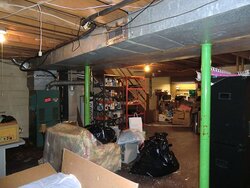
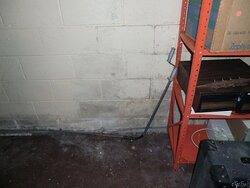
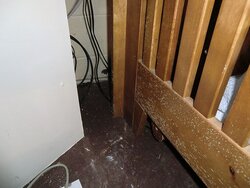
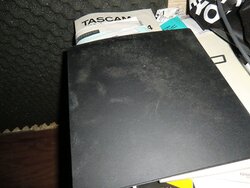
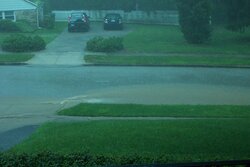
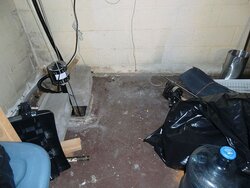
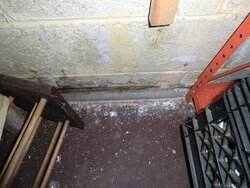
 Thanks yet again. An air test is more good advice.
Thanks yet again. An air test is more good advice.